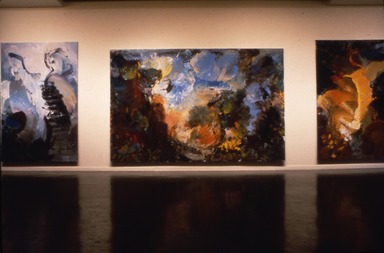
Charles Clough: Three Paintings for One Wall
DATES December 13, 1985 through February 17, 1986
ORGANIZING DEPARTMENT
Contemporary Art
COLLECTIONS
Contemporary Art
-
December 23, 1985
Three mural-size paintings by Charles Clough will be on display in the Grand Lobby from December 13 to February 17, 1986. The installation is appropriately called Three Paintings for One Wall, as the three exhibited works were created for this particular large space; all three are based on Clough’s careful study of The Brooklyn Museum’s remarkable collection of 19th- and 20th-century American paintings.
The largest of the three works, called The Governor--which measures roughly 14 by 22 feet--was inspired by Albert Bierstadt’s A Storm in the Rocky Mountains - Mt. Rosalie of 1866. Clough’s painting, like Bierstadt’s, employs a compositional scheme of a mass of brown hues on the right, the deep blue of the sky in the central part, and luminous areas of ochers and greens on the left. The two other works are both vertical and are half the size of The Governor. Doubloon was inspired by Benjamin West’s The Angel of the Lord Announcing the Ressurection, while Oysters draws freely from several works by Childe Hassam and John Henry Twachtman. All three works show Clough’s brilliant handling of colors, his gestural painting technique, and his recent interest in mastering a large-scale format. (The Bierstadt, West, Hassam, and Twachtman works can be seen in the American Painting galleries on the fifth floor of the Museum.)
Clough began doing large-scale works in the late 1970s but lost interest by the early 1980s when he became engrossed in the idea of appropriating images and ideas from artists of the past. This resulted in a reduction of scale, because his method of working utilized photographs and reproductions from books and periodicals, which were all limited in size. By 1984 he felt too constrained by the self-imposed limitations of scale and content and he began to concentrate more on free studies of his favorite masters, especially Hans Hofmann and Henri Matisse, but without drawing on specific works for inspiration. His interest in large-scale work once again came to the fore, and he devised new tools that enabled him to work on an even larger scale than before. Clough’s concern was to find ways to express his obsession with gesture and the physical properties of paint and to become immersed in the illusionistic space of the painting. The inherent romanticism of Clough’s work became readily apparent. His interest in large-scale work was reinforced during a trip to France in 1984, when he discovered at first hand the monumentality of Rubens, Courbet, and Delacroix.
“I do not reveal new unknown thoughts but continue the revelation of something which was an inspiration for myself” is Clough’s own assessment of his approach to art. By deconstructing and altering already existing imagery and reassigning it to another context, Clough reveals new qualities inherent in the original works while at the same time creating his own commentary on them.
Charles Clough was born in Buffalo in 1951. He studied at Pratt Institute in New York in 1969-70 and at Ontario College of Art in Toronto in 1971-72. In Buffalo in 1974, he and Robert Longo founded HALLWALLS, one of the first alternative spaces in the United States. Clough has resided in New York City since 1978.
Brooklyn Museum Archives. Records of the Department of Public Information. Press releases, 1971 - 1988. 1985, 061.
View Original